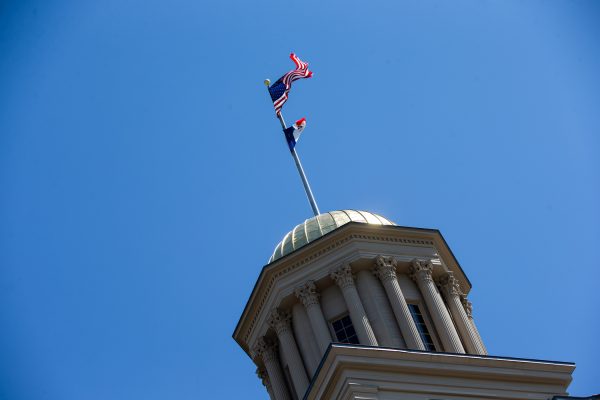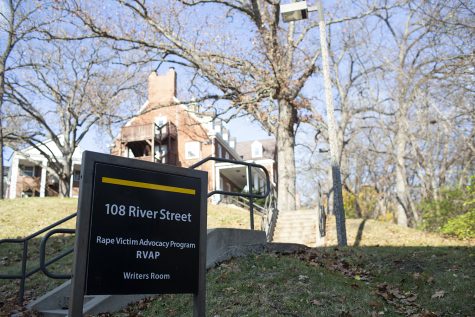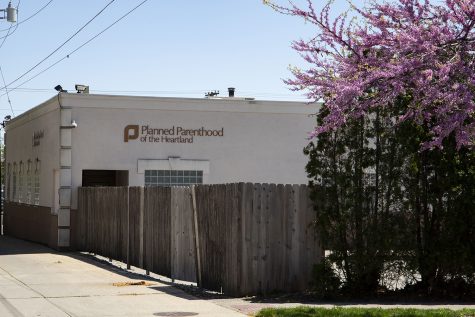High-risk drinking falls at UI, still above national average, data show
Over the last 10 years, the UI has seen a significant decline in high-risk drinking behaviors. The UI recently released its third Alcohol Harm Reduction Plan to continue the progress.
The Old Capitol building is seen in 2018.
August 1, 2019
High-risk drinking at the University of Iowa has seen a steady decrease over the last 10 years, although the behavior remains almost twice as high at the UI as the national average.
In that period, the UI witnessed a 32 percent decrease among students who reported engaging in high-risk drinking behavior in the previous week, a 30 percent drop in the number of drinks students said they drank per occasion, and a 50 percent decline in the number of students who said they drank 10 or more days per month, according to data released Aug. 1.
The UI’s spring 2019 National College Health Assessment data show in 2019, 47.7 percent of UI students surveyed said they had five or more drinks on one occasion in the previous two weeks — higher than the national average of 28.3 percent.
Tanya Villhauer, the director of student well-being and harm reduction initiatives at UI Student Life, said that while the UI has significantly reduced high-risk drinking, work still needs to be done to bring the university in line with the national average.
“We want to be sure that everybody understands the context,” she said. “If we just say, ‘We have decreased 32 percent from 2009 in high-risk drinking,’ that sounds really great, but we still need to show that we have along way to go to be close to the national average.”
RELATED: Recent data show high-risk drinking more common in UI community
The UI has addressed high-risk alcohol consumption on campus through its Alcohol Harm Reduction Plans, the first of which was established in 2009 after the formation of the Alcohol Harm Reduction Advisory Committee. Officials recently unveiled the fourth iteration of the plan, which spans 2019-22.
Villhauer said continued outreach will focus on reaching out to different demographics on campus at a higher risk for dangerous drinking behavior.
“We’ve done the low-hanging things that are easier to do,” she said. “Now, it’s digging more into the weeds and figuring out what we need to do to affect smaller groups that have higher rates of high-risk drinking. “
Reaching out to student organizations such as UI Student Government and Campus Activities Board, as well as resident assistants and Orientation leaders, has been an important part of alcohol harm-reduction initiatives, Villhauer said. Further boosting outreach to student organizations is a priority for implementing the 2019-22 plan.
RELATED: UI boosting late-night programming as alternative to drinking on weekends
Villhauer said officials have also worked with the fraternity/sorority life staff and student executive councils to connect with the greek community.
“Student Wellness has provided a lot of education and opportunity to have good education with them — not judgmental but really talking about, ‘What is your culture, how can you influence that, how can you identify areas and keep each other safe and healthy,’ ” she said.
Harm reduction in the greek community has been a priority on campus in recent years, particularly after the death of UI student Kamil Jackowski at an out-of-town formal in 2017. Community leaders banned all chapter events with alcohol “until further notice.”
There is a pilot program for chapters with no moratorium violations to hold events with alcohol under specific guidelines. The chapters were allowed to host up to three social events. The program continues, but the ban remains in effect until the campus culture around drinking makes positive strides toward change.
RELATED: 4 UI fraternities lose registered student org status, 6 on probation
The UI in December 2018 cracked down on chapters found to have violated the university’s alcohol policies, including the moratorium, revoking the registered student-organization statuses of four chapters and placing six on probation.
Another population UI President Bruce Harreld previously said the university strives to educate about forming positive health habits is first-year students, who engage in high-risk drinking at higher rates.
“Maybe they’re coming here with bad habits, maybe they’re expecting it, maybe it’s just the emotion of being free at last from home,” Harreld said in an October 2018 interview with The Daily Iowan. “It also says that there’s a small tendency in the fourth year, or as they graduate, people start celebrating a little bit early.”
In the 2019-22 plan for alcohol-harm reduction, the first goal is to “increase perception of the UI as dedicated to promoting well-being and safety as values to prospective students and families.”
The UI has made progress on its public image surrounding campus drinking culture, too, in 2018 dropping off the Princeton Review’s top-20 party school list for the first time in years.
RELATED: University of Iowa no longer a top-20 party school
Villhauer said educating first-year students on the actual rates of drinking on campus and connecting students who do not wish to drink with like-minded individuals are major goals for alcohol-harm reduction.
“We know that more students here are making the choice not to drink for however long, even if it’s a semester,” she said. “We know this. We need to really be mindful — how can we connect those students with other students that want a different experience that doesn’t include alcohol?”





















